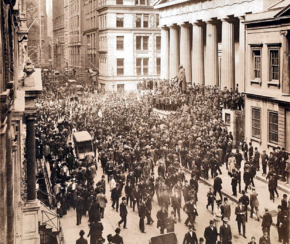Panic of 1907
The Panic of 1907 – also known as the 1907 Bankers’ Panic or Knickerbocker Crisis[1] – was a financial crisis that took place in the United States over a three-week period starting in mid-October, when the New York Stock Exchange fell almost 50% from its peak the previous year. Panic occurred, as this was during a time of economic recession, and there were numerous runs on banks and trust companies. The 1907 panic eventually spread throughout the nation when many state and local banks and businesses entered bankruptcy. Primary causes of the run included a retraction of market liquidity by a number of New York City banks and a loss of confidence among depositors, exacerbated by unregulated side bets at bucket shops.[2]

The panic was triggered by the failed attempt in October 1907 to corner the market on stock of the United Copper Company. When this bid failed, banks that had lent money to the cornering scheme suffered runs that later spread to affiliated banks and trusts, leading a week later to the downfall of the Knickerbocker Trust Company—New York City’s third-largest trust. The collapse of the Knickerbocker spread fear throughout the city’s trusts as regional banks withdrew reserves from New York City banks. Panic extended across the nation as vast numbers of people withdrew deposits from their regional banks. It is the 9th largest decline in U.S. stock market history.[3]
The panic might have deepened if not for the intervention of financier J. P. Morgan,[4] who pledged large sums of his own money, and convinced other New York bankers to do the same, to shore up the banking system. This highlighted the impotence of the nation’s Independent Treasury system, which managed the nation’s money supply yet was unable to inject liquidity back into the market. By November, the financial contagion had largely ended, only to be replaced by a further crisis. This was due to the heavy borrowing of a large brokerage firm that used the stock of Tennessee Coal, Iron and Railroad Company (TC&I) as collateral. Collapse of TC&I’s stock price was averted by an emergency takeover by Morgan’s U.S. Steel Corporation—a move approved by anti-monopolist president Theodore Roosevelt. The following year, Senator Nelson W. Aldrich, a leading Republican, established and chaired a commission to investigate the crisis and propose future solutions, leading to the creation of the Federal Reserve System.[5][6]
<snip>
The Treason of the Senate Get Rid of the Filibuster
The filibuster is a piratical obstruction of the Senate’s business in the name of white supremacy and nothing else. The Filibuster has been blocking an anti-lynching law for a CENTURY.
The Treason of the Senate was a series of articles in Cosmopolitan magazine by David Graham Phillips, published in 1906.
What is the origin of Dr Knickerbocker number nine?
DOCTOR KNICKRBOCKER NUMER 9
and
ENGINE ENGINE NUMBER 9
Plato warned that reading would be the downfall of the
Oral Tradition and memory.
THE NAME …
The term “Knickerbockers” traces its origin back to the Dutch settlers who came to the New World — and especially to what is now New York — in the 1600s. Specifically, it refers to the style of pants the settlers wore … pants that rolled up just below the knee, which became known as “Knickerbockers,” or “knickers”.
Through history, the Dutch settler “Knickerbocker” character became synonymous with New York City. The city’s most popular symbol of the late 19th and early 20th centuries was “Father Knickerbocker,” complete with cotton wig, three-cornered hat, buckled shoes, and, of course, knickered pants.
